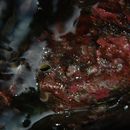Biology
provided by Arkive
All abalones are herbivorous, and use their large, rough, file-like 'tongues' (radulas) to scrape pieces of algae and other plant material from rock surfaces, as well as feeding on loose pieces of algae and phytoplankton drifting in the water (2) (4). Sea urchins compete with the abalone for food and space, and usually win. Abalone are also key prey for predators such as octopus, crab, lobsters, starfish and sea otters (2).
The northern abalone is generally dioecious (separate male and female individuals), although some hermaphrodites (individuals with both male and female reproductive organs) have also been recorded. Sexual maturity is typically reached at 50 mm in length, after about three years of age (2). Spawning, which requires temperatures between 10 and 14ºC, takes place from April to August, when all the male and female abalone in the area simultaneously release their gametes into the water (2) (7). A female abalone can release up to three million eggs, but less than 1% of the offspring are likely to survive to maturity (2) (4). The larvae drift with the currents for about a week before settling to the bottom and developing the adult shell form (4) (5).
Conservation
provided by Arkive
There are now a number of conservation measures underway to protect the northern abalone. A total ban on harvesting this species came into force in 1990 in British Columbia, and partial bans and catch quotas now also exist elsewhere. A National Recovery Strategy and National Recovery Action Plan have been created in Canada, which focus on improving law enforcement, raising public support through communication campaigns, conducting further research on the species, and ongoing monitoring of its status and population trends. Although supplementing northern abalone populations could help accelerate its recovery, reintroductions of hatchery-raised juveniles has proved costly and fairly ineffective in the past and therefore is not recommended as a valuable conservation tool in this instance (1).
Description
provided by Arkive
Abalone species (Haliotis) are one of the most primitive group of molluscs on the planet, having changed little in the last 500 million years (2). The scientific name - Haliotis – means 'sea ear', referring to the flattened, oval shape of the shell (3). The northern abalone's shell exterior is mottled greenish brown with scattered areas of white and blue (4). These colours mostly come from algae pigments in the species' waste, and are a great help with camouflage (2) (3). By contrast, the interior of the shell is pearly-white with a feint pink and green sheen (3). A row of three to six raised breathing holes line the outer edge of the shell, followed by several bumps (2) (3) (5). As the abalone grows, these openings fuse and are replaced (3). Sometimes the abalone will stick its thin yellowish-brown to green tentacles through these openings, in order to keep them clear (2) (4). A muscular foot at the base of the shell allows the abalone to clamp tightly to rocky surfaces on the sea bed (4).
Habitat
provided by Arkive
Aggregations of northern abalone can be found along coastal waters where there is good water circulation, clinging to rocks amongst kelp beds (1) (4). Adults are typically found within 10 m of the surface, although there are reports of them as deep as 100 m (3) (6). Abalone larvae are free-swimming for the first week to ten days of life, before settling to the bottom and becoming more sedentary (3) (5). Unlike adults that prefer to settle amongst and feed on large brown algae such as kelp, juveniles tend to cluster around crustose red algae patches, and migrate much more than adults (2).
Range
provided by Arkive
Found along the Pacific coast of America from Sitka Island, Alaska, in the north, to Turtle Bay, Baja California in the south (1).
Status
provided by Arkive
Classified as Endangered (EN) on the IUCN Red List 2006 (1).
Threats
provided by Arkive
Abalone have been harvested for hundreds of years for their meat and their decorative shells, but their remote environment previously limited the impact this had on populations (2) (3). However, the introduction of SCUBA equipment in the 1960s meant that abalone could be collected in far greater numbers, and led to the rampant over-harvesting and drastic decline of this species, to the extent that collecting this species was eventually banned over much of its range (2) (5). However, illegal poaching, which is a lucrative enterprise motivated by high demand and elevated market prices due to the species' scarcity, continues to pose a serious threat to the northern abalone (3). Furthermore, there are law enforcement problems due to North America having large areas of uninhabited coastline, in which constant monitoring is near impossible (1).
Other important threats to the northern abalone are predation and competition. The sea otter is one of the species' major natural predators (3), but currently the two species overlap only within the north of the northern abalone's range. This is due to over-exploitation of the otter throughout the Western Pacific rim at the end of the 18th century, leading to its extinction in British Columbia, Washington, most of California, and much of Alaska (1). Where the two species coexist, sea otters are believed to consume northern abalone in significant numbers, and their growing numbers and rapid re-establishment due to significant conservation measures are predicted to hinder northern abalone recovery. Sea urchins out compete the northern abalone for food and space, and may also impact their numbers (1).

